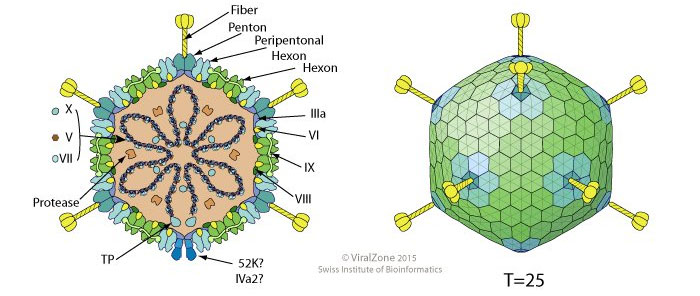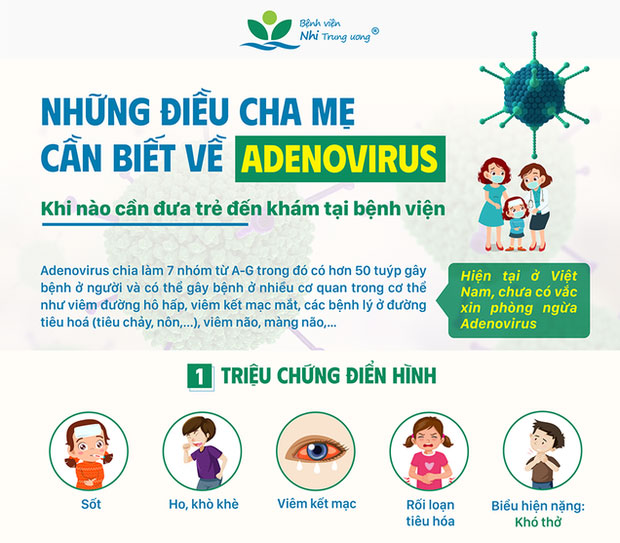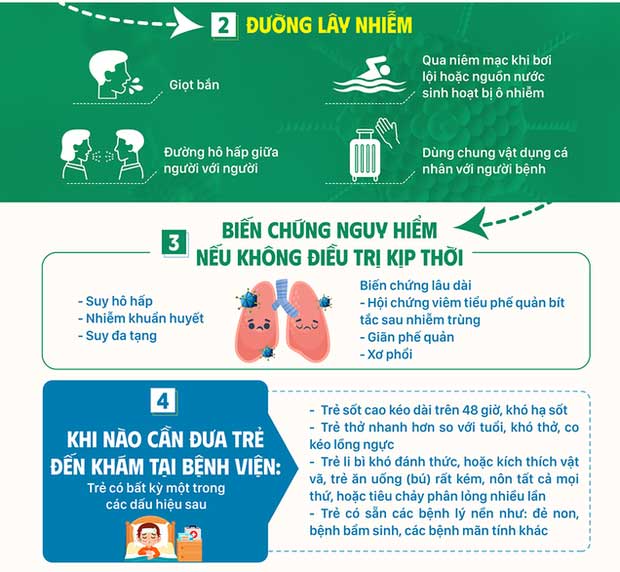Adenovirus is one of the leading causes of respiratory infections in humans, particularly affecting infants and young children. It is especially known for causing pneumonia in children, with a mortality rate of 8-10%. In addition to respiratory infections, adenoviruses can also affect various other organs, leading to conditions such as conjunctivitis and gastroenteritis.
Understanding Adenovirus
What is Adenovirus?
Adenoviruses are double-stranded DNA viruses with a symmetrical capsid arranged in an icosahedral shape, with a diameter ranging from 70 to 80 nm. They were first discovered in 1953 from adenoid tissue.
There are at least 47 serotypes of adenovirus. Serotypes 1-5, 7, 14, and 21 are known to cause diseases such as pharyngitis and conjunctivitis; serotypes 40 and 41 are associated with acute diarrhea in children; serotypes 5, 8, and 19 are often linked to severe illness.
Adenoviruses exhibit strong resistance, capable of surviving and remaining infectious at 36°C for 7 days, at 22°C for 14 days, and at 4°C for 70 days. The virus loses its virulence and dies at 56°C within 3 to 5 minutes.

Adenovirus Structure.
Is Adenovirus Dangerous?
Adenovirus can spread rapidly within communities and lead to many serious complications, often with very common symptoms.
Reports indicate that adenovirus has caused outbreaks of fever, pharyngitis, and conjunctivitis in various parts of the world. Hemorrhagic conjunctivitis outbreaks were first identified in Ghana in 1969 and Indonesia in 1970, with subsequent outbreaks occurring in tropical regions of Asia, Africa, Central and South America, the Caribbean, some parts of Florida and Mexico. Additionally, smaller outbreaks have been reported in Europe and among Southeast Asian refugees in the United States.
In Vietnam, adenovirus is widely circulating throughout the country and can occur sporadically throughout the year, particularly in the spring and summer months, making it easy to confuse with respiratory infections caused by other viruses or with dengue fever at the beginning of summer.
What Diseases Does Adenovirus Cause?
Adenovirus can adversely affect various organs, including the respiratory system, eyes, gastrointestinal tract, and other organs. Group B adenoviruses are the most common viral pathogens. After invading the body, adenoviruses can persist in the tonsils for many years.
Adenoviruses can cause several diseases, including:
Respiratory Infections
Acute Pharyngitis: Common in infants and young children, symptoms include fever, headache, sore throat, cough, and runny nose. This condition can last from 7 to 14 days and spread rapidly in outbreaks. If diagnosed solely based on symptoms, it can be challenging to distinguish from other viral respiratory diseases.
Acute Respiratory Infection: Symptoms include sore throat, swollen lymph nodes in the neck, fever up to 39°C, and cough. This illness can affect both children and adults, has an acute onset, and typically resolves after 3-4 days. The adenovirus strains commonly associated with this illness are 4 and 7.
Pneumonia: Adenovirus accounts for 10% of acute pneumonia cases in young children. The disease often appears suddenly with high fever above 39°C, runny nose, and signs of lung damage. These lesions can spread, leading to complications and, in severe cases, death. Pneumonia caused by adenovirus can result in dangerous complications and has a mortality rate of 8-10% among infected individuals.
Conjunctivitis
Adenovirus has long been recognized as a leading cause of conjunctivitis. Family transmission rates are estimated to be between 10-50%.
There are four main clinical forms of adenoviral conjunctivitis:
- Follicular conjunctivitis
- Febrile conjunctivitis
- Acute conjunctivitis with non-specific follicles
- Chronic conjunctivitis
It is essential to differentiate it from conjunctivitis caused by Chlamydia, other viral strains, and allergic conjunctivitis.

Adenovirus is known as a leading cause of conjunctivitis.
Acute Gastroenteritis
Adenovirus is also one of the common agents causing acute gastroenteritis. Gastroenteritis due to adenovirus ranks second after rotavirus in causing acute diarrhea in young children. Acute diarrhea caused by adenovirus is often associated with serotypes 40 and 41.
Other Diseases
Adenovirus can also cause hemorrhagic cystitis in children, particularly in boys. This virus can be found in the urethra and uterus, and is considered a sexually transmitted infection.
Additionally, some viral infections may present without symptoms, known as asymptomatic cases, which are significant sources of community transmission. Patients who recover from adenovirus infections develop high and lasting immunity to the specific serotype that caused their illness but do not have cross-immunity to other serotypes.
This virus spreads easily within communities and can lead to many dangerous complications from seemingly mild symptoms. Therefore, when children exhibit signs suggestive of adenovirus infection, it is crucial to monitor their health regularly and seek medical attention immediately if any abnormal signs arise.
Symptoms of Adenovirus Infection
Most cases of adenovirus infection are asymptomatic. Symptomatic cases often present a wide range of clinical manifestations since most adenovirus strains that cause mild disease have an affinity for multiple tissue types.
Symptomatic infections commonly occur in children with upper respiratory tract infections, including fever, sore throat, otitis media, and tonsillitis. Some less common adenovirus-related conditions include conjunctivitis and gastroenteritis.
Adenoviral conjunctivitis typically presents suddenly with red eyes, excessive eye discharge, and sore throat. Gastroenteritis often manifests as prolonged watery diarrhea lasting up to 7 days, accompanied by nausea, fever, respiratory symptoms, and conjunctivitis.
Transmission of Adenovirus
Adenovirus is transmitted via respiratory droplets from person to person. The virus can spread through mucous membranes when swimming or through contaminated water sources used for daily activities, or through shared personal items between healthy individuals and infected patients. The virus commonly spreads in clinics, particularly eye clinics. Healthcare workers are at high risk of contracting the virus, thus becoming a source of transmission to patients and their families.
Diagnosis of Adenovirus Infection
Specimen Collection
Specimens should be collected from the affected organ or where the virus is localized. Clinical specimens can include stool, urine, throat swabs, and conjunctival secretions.
Virus Isolation and Identification
After processing, the specimens are cultured on human-derived cells, such as human embryonic kidney cells. Other epithelial cells like HeLa, Hep-2, and KB are sensitive but difficult to apply due to the long culture time (up to 28 days) required to detect slow-growing viruses.
To identify adenovirus types, doctors can use fluorescent antibodies or conduct complement fixation tests (CF) to isolate specific group antigens. Additionally, hemagglutination reactions can help identify virus strains.
To definitively differentiate adenoviruses into various groups, PCR techniques are often employed. Using body fluid specimens, primers are designed for gene segments coding specific antigens, allowing detection of most virus types.
To detect the virus in human stool, electron microscopy or ELISA techniques can be utilized.
Treatment Methods for Adenovirus Infection
Currently, there is no specific treatment for adenovirus. Most medications available are symptomatic treatments, combined with supportive care and vitamin C. The illness can resolve within a few days if treated appropriately. However, if patients experience complications such as conjunctivitis or pneumonia, the illness may last a week or longer.
Children with adenovirus infections should be encouraged to drink plenty of fluids, as they often lose significant amounts of water due to fever, vomiting, and diarrhea. The best options for rehydration include fruit juices and water, and electrolyte solutions may also be provided.
Parents should regularly help their children clear their noses. For infants, the CDC recommends that family members put a few drops of saline solution into the baby’s nose and then use a syringe to suction out the mucus. Parents can also turn on a humidifier or use a misting spray to alleviate nasal congestion, making it easier for the child to breathe.
Note: Before using any medication, parents should consult with a doctor. Experts advise against giving children any medication containing aspirin, as it may lead to rare conditions such as Reye’s syndrome, which causes swelling of the brain and liver, affecting the child’s health and recovery ability.
Preventing Adenovirus Infections
In areas where Adenovirus outbreaks occur, residents should pay attention to personal hygiene, especially the hygiene of the nose, throat, and eyes. Regularly use clean water and wash face towels with soap.
Healthy individuals should absolutely not share personal items with infected individuals, especially face towels and items that may have been contaminated with the patient’s secretions, such as bowls, cups, spoons, beds, and mats. It is advisable to disinfect and sanitize the patient’s belongings during the acute phase of the illness and to perform a final disinfection after the patient has recovered using regular cleaning agents.
An infographic about Adenovirus that is simple and easy to understand, which parents should know:























































